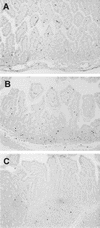Simian immunodeficiency virus infection in neonatal macaques
- PMID: 12885897
- PMCID: PMC167220
- DOI: 10.1128/jvi.77.16.8783-8792.2003
Simian immunodeficiency virus infection in neonatal macaques
Abstract
Children with human immunodeficiency virus infection often have higher viral loads and progress to AIDS more rapidly than adults. Since the intestinal tract is a major site of early viral replication and CD4(+) T-cell depletion in adults, we examined the effects of simian immunodeficiency virus (SIV) on both peripheral and intestinal lymphocytes from 13 neonatal macaques infected with SIVmac239. Normal neonates had more CD4(+) T cells and fewer CD8(+) T cells in all tissues than adults. Surprisingly, neonates had substantial percentages of CD4(+) T cells with an activated, memory phenotype (effector CD4(+) T cells) in the lamina propria of the intestine compared to peripheral lymphoid tissues, even when examined on the day of birth. Moreover, profound and selective depletion of jejunum lamina propria CD4(+) T cells occurred in neonatal macaques within 21 days of infection, which was preceded by large numbers of SIV-infected cells in this compartment. Furthermore, neonates with less CD4(+) T-cell depletion in tissues tended to have higher viral loads. The persistence of intestinal lamina propria CD4(+) T cells in some neonates with high viral loads suggests that increased turnover and/or resistance to CD4(+) T-cell loss may contribute to the higher viral loads and increased severity of disease in neonatal hosts.
Figures







Similar articles
-
Elite Control, Gut CD4 T Cell Sparing, and Enhanced Mucosal T Cell Responses in Macaca nemestrina Infected by a Simian Immunodeficiency Virus Lacking a gp41 Trafficking Motif.J Virol. 2015 Oct;89(20):10156-75. doi: 10.1128/JVI.01134-15. Epub 2015 Jul 29. J Virol. 2015. PMID: 26223646 Free PMC article.
-
Simian immunodeficiency virus selectively infects proliferating CD4+ T cells in neonatal rhesus macaques.Blood. 2010 Nov 18;116(20):4168-74. doi: 10.1182/blood-2010-03-273482. Epub 2010 Aug 17. Blood. 2010. PMID: 20716768 Free PMC article.
-
Loss of virus-specific CD4(+) T cells with increases in viral loads in the chronic phase after vaccine-based partial control of primary simian immunodeficiency virus replication in macaques.J Gen Virol. 2004 Jul;85(Pt 7):1955-1963. doi: 10.1099/vir.0.79890-0. J Gen Virol. 2004. PMID: 15218180
-
Critical Role for Monocytes/Macrophages in Rapid Progression to AIDS in Pediatric Simian Immunodeficiency Virus-Infected Rhesus Macaques.J Virol. 2017 Aug 10;91(17):e00379-17. doi: 10.1128/JVI.00379-17. Print 2017 Sep 1. J Virol. 2017. PMID: 28566378 Free PMC article.
-
The Hitchhiker Guide to CD4+ T-Cell Depletion in Lentiviral Infection. A Critical Review of the Dynamics of the CD4+ T Cells in SIV and HIV Infection.Front Immunol. 2021 Jul 21;12:695674. doi: 10.3389/fimmu.2021.695674. eCollection 2021. Front Immunol. 2021. PMID: 34367156 Free PMC article.
Cited by
-
Initiation of ART during early acute HIV infection preserves mucosal Th17 function and reverses HIV-related immune activation.PLoS Pathog. 2014 Dec 11;10(12):e1004543. doi: 10.1371/journal.ppat.1004543. eCollection 2014 Dec. PLoS Pathog. 2014. PMID: 25503054 Free PMC article. Clinical Trial.
-
CD4+ T cell depletion during all stages of HIV disease occurs predominantly in the gastrointestinal tract.J Exp Med. 2004 Sep 20;200(6):749-59. doi: 10.1084/jem.20040874. Epub 2004 Sep 13. J Exp Med. 2004. PMID: 15365096 Free PMC article.
-
Role of Monocyte/Macrophages during HIV/SIV Infection in Adult and Pediatric Acquired Immune Deficiency Syndrome.Front Immunol. 2017 Dec 5;8:1693. doi: 10.3389/fimmu.2017.01693. eCollection 2017. Front Immunol. 2017. PMID: 29259605 Free PMC article. Review.
-
Rapid virus dissemination in infant macaques after oral simian immunodeficiency virus exposure in the presence of local innate immune responses.J Virol. 2006 Jul;80(13):6357-67. doi: 10.1128/JVI.02240-05. J Virol. 2006. PMID: 16775324 Free PMC article.
-
The rhesus macaque pediatric SIV infection model - a valuable tool in understanding infant HIV-1 pathogenesis and for designing pediatric HIV-1 prevention strategies.Curr HIV Res. 2009 Jan;7(1):2-11. doi: 10.2174/157016209787048528. Curr HIV Res. 2009. PMID: 19149549 Free PMC article. Review.
References
-
- Anton, P. A., J. Elliott, M. A. Poles, I. M. McGowan, J. Matud, L. E. Hultin, K. Grovit-Ferbas, C. R. Mackay, I. S. Y. Chen, and J. V. Giorgi. 2000. Enhanced levels of functional HIV-1 co-receptors on human mucosal T cells demonstrated using intestinal biopsy tissue. AIDS 14:1761-1765. - PubMed
-
- Butler, K. M., and P. A. Pizzo. 1992. HIV infection in children, p. 285-312. In V. T. DeVita, Jr., S. Hellman, and S. A. Rosenberg (ed.), AIDS: etiology, diagnosis, treatment, and prevention, 3rd ed. J. B. Lippincott Co., Philadelphia, Pa.
-
- DeMaria, M. A., M. Casto, M. O'Connell, R. P. Johnson, and M. Rosenzweig. 2000. Characterization of lymphocyte subsets in rhesus macaques during the first year of life. Eur. J. Haematol. 65:245-257. - PubMed
-
- de Martino, M., P.-A. Tovo, M. Balducci, L. Galli, C. Gabiano, G. Rezza, and P. Pezzotti. 2000. Reduction in mortality with availability of antiretroviral therapy for children with perinatal HIV-1 infection. JAMA 284:190-197. - PubMed
Publication types
MeSH terms
Substances
Grants and funding
LinkOut - more resources
Full Text Sources
Research Materials

